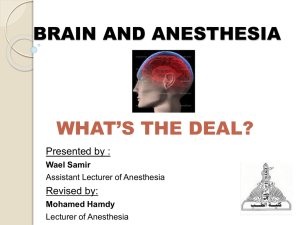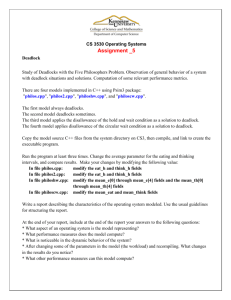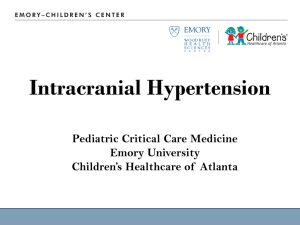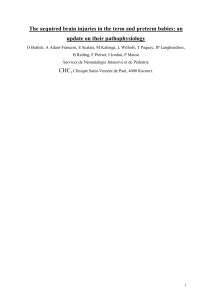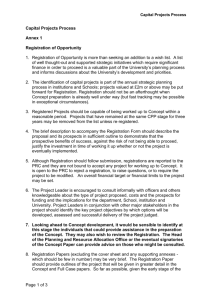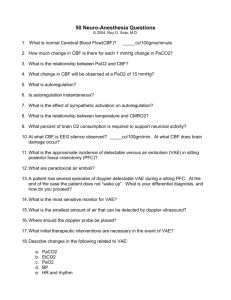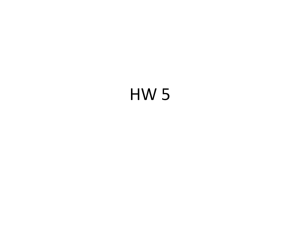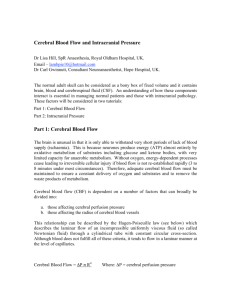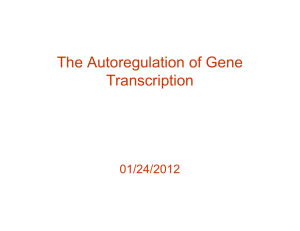Lecture 3
advertisement
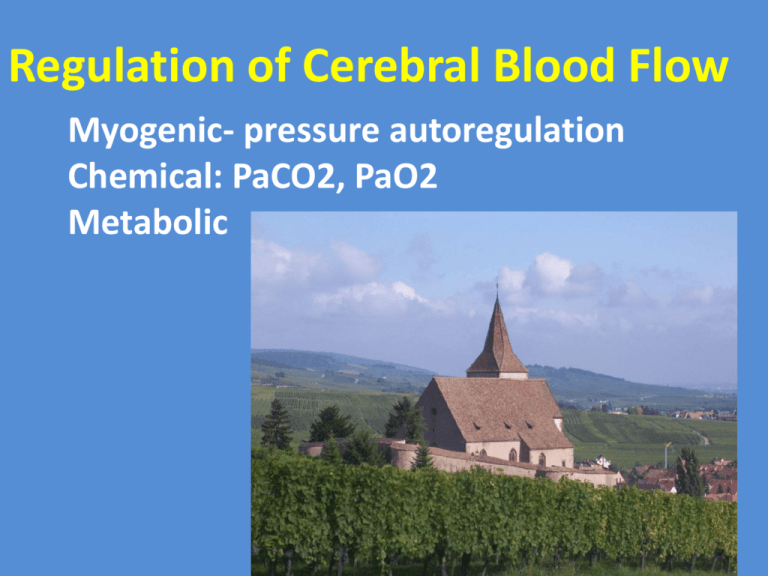
Regulation of Cerebral Blood Flow Myogenic- pressure autoregulation Chemical: PaCO2, PaO2 Metabolic Flow through rigid tube Experimental data: Falling CPP. Lassen was right! Lassen’s curve by averaging large number of measurements in TBI (nearly 200 patients, monitored with TCD day-by-day) Autoregulation of cerebral blood flow CBF [ml/min/100g] 60 40 20 12 50 150 CPP [mmHg] CBF = CPP/R Thanks to Dr. A Lavinio CBF [ml/min/100g] 60 40 20 12 50 150 CPP [mmHg] Thanks to Dr. A Lavinio ‘Historical’ block diagram illustrating general control loops for CBF Thanks to Dr.DJ Kim General scheme of various factors controlling simultaneously CBF Delay of autoregulation- around 10 seconds. Is it always constant? Distribution of vascular reactivity to CO2 R arterial (D) = exp((3.57)-(1.1)*log(D))+(.68) Rvenous(D) = 0.20*Rarterial (D) [%/mmHgCO 2] 9 8 Ref: Tuor '84 Ref: Levasseur '89 Ref: Wei '80(norm) 7 Ref: Wei '80 Ref: Bouma '91 6 Ref: Raper '71 Ref: Lee '01 5 6 1 1 5 1 1 3 2 21 11 9 19 9 9 18 1 12 1911 19 9 11 1 16 1 1 28 30 1 1 1 1 1 1 1 11 1 1 4 1 16 16 1 11 1 1 3 1 1 1 1 1 1 1 1 2 1 5 5 5 0 0 600 400 700 500 300 8 7 1 1 8 Ref: Lee '01 ---- Venous Model 1 Ref: Auer '80 ---- Arterial Model 6 9 1 4 1 [%/mmHgCO2 ] 200 90 70 50 100 80 60 40 Thanks to Dr. S.Piechnik 30 20 66 8 410 104 8 75 9 9 57 30 20 50 40 70 90 60 80 100 200 400 300 600 500 700 Interaction between cerebral autoregulation and cerebrospinal pressure- volume compensation- potential for unstable behaviour Clinical AUTOREGULATION assessment . What do we need? TCD, ABP and, possibly, ICP CO2 reactivity = % change in FV / % change in CO2 Correction for changes in ABP? Change in PaCO2 (at normal ICP and normal ABP), 0- hypocania, 1-normocapnia 2hypercapnia. How ‘primary variables’ react to PaCO2? (Stroke. 1998;29:968-974.) Can Cerebrovascular Reactivity Be Assessed Without Measuring Blood Pressure in Patients With Carotid Artery Disease? J. Dumville, PhD; R. B. Panerai, PhD; N. S. Lennard, MBChB; A. R. Naylor, MD; ;D. H. Evans, PhD CBF= a*EtCO2 +b*ABP METHODS: Static rate of autoregulation: pharmacological increase in ABP SRoR= % Change in CVR / % change in CPP CBF CBF and CVR‘geometrical’ interpretation ‘hyper’ AR ideal AR ‘Critical closing’ Insufficient AR CPP S CVR Maximal Vasoconstriction SRoR<1 SRoR=1 Maximal vasodilatation SRoR>1 CPP CCP LLAR ULAR SRoR= (ΔCVR/CVR)/ (ΔCPP/CPP) ICP [mm Hg] ABP [mm Hg] CBFV [cm/s] CPP [mm Hg] CBFV [cm/s] CPP [mm Hg] ‘INVERSE LASSEN CURVE’? Leg-cuff release (R.Aaslid et al. Stroke. 1989 ;20(1):45-52) RoR Tiecks FP, Lam AM, Aaslid R, Newell DW Comparison of static and dynamic cerebral autoregulation measurements. Stroke. 1995 Dec;26(12):2372-3. ABPbaseline dCVR 1 dt CVRbaseline ABP , Frank P. Tiecks, MD; Arthur M. Lam, MD, FRCPC; Rune Aaslid, PhD; David W. Newell, MD Comparison of Static and Dynamic Cerebral Autoregulation Measurements (Stroke. 1995;26:1014-1019.) The effect of the cerebral autoregulation on mean velocity (mV) was approximated by a second-order linear differential equation set with state variables x1 and x2, which were assumed to be equal to 0 during the control period. After the step in ABP, these equations were solved by the computer in steps of 100 milliseconds (sampling rate, f=10 Hz) by the algorithm where dP is the normalized change in mean arterial blood pressure (MABP) from its control value (cABP), including the effect of the critical closing pressure (CCP), which was assumed to be constant at 12 mm Hg in the present study. (This parameter can later be estimated individually.) MABP was obtained by filtering the pulsatile ABP at 0.5 Hz. cVmca is control velocity in the MCA. The control values were obtained as explained in "Methods." This mathematical model was characterized by three parameters: T, the time constant; D, the damping factor; and K, the autoregulatory dynamic gain. The same ARI may be derived from slow waves of ABP and TCD Panerai R: Cardiovasc Eng (2008) 8:42–59 Transient hyperaemic response test (Giller CA. Acta Neurochir (Wien). 1991;108(1-2):714) Consequence of disturbed autoregulation: ischaemic insult during plateau wave of ICP Consequence of arterial hypotension Arterial hypotension with baseline autoregulation probably deteriorated Carotid artery stenotic disease: left side impairment of reactivity, 85% of stenosis. Right side clear. POINTS TO TAKE HOME: Several mechanisms of CBF regulation work simultaneously Pressure-autoregulation is potent brain self-protecting mechanism Autoregulation fails if CPP is too low or too high Autoregulation fails if arterial CO2 is too high Autoregulation may be tested in clinical conditions Consequences of disturbed autoregulation: Brain is exposed to ischemic insults when CPP decreases, this may reduce chance for good outcome after TBI With high CPP hyperaemia may aggravate brain oedema causing secondary rise of ICP

